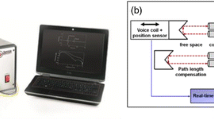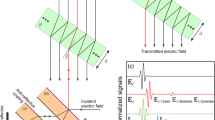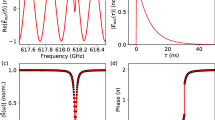Abstract
Time-domain terahertz (THz), multi-terahertz, and Fourier transform infrared (FTIR) spectroscopies access partly similar and partly complementary spectral ranges of the far-infrared region. We introduce an approach enabling a direct comparison of their performance in terms of the signal-to-noise ratio (SNR) and dynamic range (DR), normalized by the time required to obtain one useful data point in the frequency domain. Several configurations of a commercial FTIR spectrometer are compared to our various custom-built time-domain systems (including femtosecond oscillator and amplifier-based THz and multi-THz setups). We find that the normalized SNR of the FTIR systems is generally better than that of the time-domain setups, which is attributed to the noise of the femtosecond laser output compared to the black body radiation source. On the other hand, the coherent detection of the THz field in the time-domain systems leads to a dramatically better normalized DR than in the FTIR configurations.





Similar content being viewed by others
References
K.-E. Peiponen, J. A. Zeitler, M. Kuwata-Gonokami (eds.), Terahertz Spectroscopy and Imaging (Springer 2013).
J. Hlinka, T. Ostapchuk, D. Nuzhnyy, J. Petzelt, P. Kužel, C. Kadlec, P. Vaněk, I. Ponomareva, and L. Bellaiche, Phys. Rev. Lett. 101, 167402 (2008).
A. Pimenov, A. A. Mukhin, V. Y. Ivanov, V. D. Travkin, A. M. Balbashov, and A. Loidl, Nat. Phys. 2, 97 (2006).
N. Kida, Y. Takahashi, J. S. Lee, R. Shimano, Y. Yamasaki, Y. Kaneko, S. Miyahara, N. Furukawa, T. Arima, and Y. Tokura, J. Opt. Soc. Am. B 26, A35 (2009).
M. C. Beard, G. M. Turner, and C. A. Schmuttenmaer, Phys. Rev. B 62, 15764 (2000).
H.-K. Nienhuys and V. Sundström, Appl. Phys. Lett. 87, 012101 (2005).
P. Kužel and H. Němec, J. Phys. D – Appl. Phys. 47, 374005 (2014).
M. Beck, I. Rousseau, M. Klammer, P. Leiderer, M. Mittendorff, S. Winnerl, M. Helm, G. N. Goltsman, and J. Demsar, Phys. Rev. Lett. 110, 267003 (2013).
J. E. Boyd, A. Briskman. V. L. Colvin, and D. M. Mittleman, Phys. Rev. Lett 87, 147401 (2001).
B. P. Gorshunov, V. I. Torgashev, E. S. Zhukova, V. G. Thomas, M. A. Belyanchikov, C. Kadlec, F. Kadlec, M. Savinov, T. Ostapchuk, J. Petzelt, J. Prokleška, P. V. Tomas, E. V. Pestrjakov, D. A. Fursenko, G. S. Shakurov, A. S. Prokhorov, V. S. Gorelik, L. S. Kadyrov, V. V. Uskov, R. K. Kremer, and M. Dressel, Nat. Commun. 7, 12842 (2016).
R. Ulbricht, E. Hendry, J. Shan, T.F. Heinz, and M. Bonn, Rev. Mod. Phys. 83, 543 (2011).
C. Kübler, R. Huber, S. Tübel, and A. Leitenstorfer, Appl. Phys. Lett. 85, 3360 (2004).
P. Y. Han, M. Tani, M. Usami, S. Kono, R. Kersting, and X.-C. Zhang, J. Appl. Phys. 89, 2357 (2001).
M. Naftaly and R. Dudley, Opt. Lett. 34, 1213 (2009).
T. Wang, K. Iwaszczuk, E. A. Wrisberg, E. V. Denning, and P. Uhd Jepsen, J. Infrared Milli. Terahz. Waves 37, 592 (2016).
P. Uhd Jepsen and B. M. Fischer, Opt. Lett. 30, 29 (2005).
Note that in the case of TDS these n spectral values consist of n/2 real and n/2 imaginary values (or n/2 independent amplitude and phase values). In contrast, in the case of FTIR the phase does not bring any information about the sample: its values are implied by the symmetry of the interferogram and by electronic filtering of the signal. Information is then carried only by n/2 independent spectral power values.
In most instruments, the acquisition involves blind intervals such as delay line return, during which no useful data are acquired. In order to keep our reasoning as simple as possible, we did not consider such intervals in the definitions of per-scan measurement time etc. Nevertheless, such intervals are automatically reflected in all subsequent formulae when we replace u by the scanning velocity defined as the ratio of nΔt to the total acquisition time needed for a single complete scan period (including the blind parts).
J. S. Bendat and S. G. Piersol, Random Data analysis and Measurement Procedures (Wiley, 2000).
P. Kužel, H. Němec, F. Kadlec, and C. Kadlec, Opt. Express 18, 15338 (2010).
M. D. Thomson, M. Kress, T. Löffler, H. G. Roskos, Laser & Photon. Rev. 1, 349 (2007).
N. Karpowicz, J. Dai, X. Lu, Y. Chen, M. Yamaguchi, H. Zhao, X.-C. Zhang, Appl. Phys. Lett. 92, 011131 (2008).
X. Lu and X.-C. Zhang, Appl. Phys. Lett. 98, 151111 (2011).
It would be theoretically possible to increase the DR of the spectrometer equipped with the liquid He-cooled bolometer by inserting a filter into the beam path for a high-signal measurement (i.e. for any reference measurement) and remove it for a low-signal measurement (i.e.. for any sample measurement). However, this is quite problematic since, using this scheme, the reference would be always measured in different conditions than the sample and quantitative and reproducible determination of the spectra over a broad spectral range and without artifacts would be hardly achieved. This option is not used in practice and the devices are not equipped with such a possibility.
S. Glinšek, D. Nuzhnyy, J. Petzelt, B. Malič, S. Kamba, V. Bovtun, M. Kempa, V. Skoromets, P. Kužel, I. Gregora, and M. Kosec, J. Appl. Phys. 111, 104101 (2012).
C. Kadlec, F. Kadlec, H. Němec, P. Kužel, J. Schubert, and G. Panaitov, J. Phys.: Cond. Matter. 21, 115902 (2009).
K. L. Krewer, Z. Mics, J. Arabski, G. Schmerber, E. Beaurepaire, M. Bonn, and D. Turchinovich, Opt. Lett. 43, 447 (2018).
F. Junginger, A. Sell, O. Schubert, B. Mayer, D. Brida, M. Marangoni, G. Cerullo, A. Leitenstorfer, and R. Huber, Opt. Lett. 35, 2465 (2010).
T. Seifert et al., Nat. Photon. 10, 483 (2016).
Y. C. Shen, P. C. Upadhya, E. H. Linfield, H. E. Beere, and A. G. Davies, App. Phys. Lett. 83, 3117 (2003).
Funding
This work is supported by the Operational Programme Research, Development and Education financed by European Structural and Investment Funds and the Czech Ministry of Education, Youth and Sports (Project No. SOLID21- CZ.02.1.01/0.0/0.0/16_019/0000760). PK and HN also acknowledge the financial support by the Czech Science Foundation (Project No. 17-03662S).
Author information
Authors and Affiliations
Corresponding author
Rights and permissions
About this article
Cite this article
Skoromets, V., Němec, H., Goian, V. et al. Performance Comparison of Time-Domain Terahertz, Multi-terahertz, and Fourier Transform Infrared Spectroscopies. J Infrared Milli Terahz Waves 39, 1249–1263 (2018). https://doi.org/10.1007/s10762-018-0544-9
Received:
Accepted:
Published:
Issue Date:
DOI: https://doi.org/10.1007/s10762-018-0544-9




